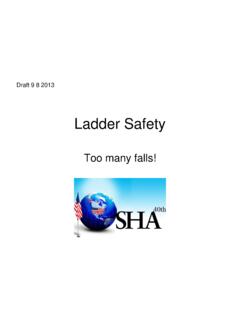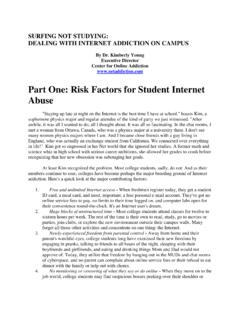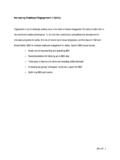Transcription of Daily Safety Focus articles - UCA
1 Daily Safety Focus articles February 2014 Focus on Guiding Principle: People are the most critical element. February 2014 Safety Focus Topics February 1 - Complacency February 2 - Safety , It's your Choice February 3 - Luck Has Nothing to do with Safety February 4 - Are You Safe or Just Lucky? February 5 - Slips, Trip and Falls - Pay Attention February 6 - Give Yourself a Hand February 7 - Lifting Properly February 8 - Thoughts to start the work day February 9 - Accept It - It's Yours February 10 - Prevent Back Strains and Pains on the Job February 11 - Take a Close Look at Close Calls February 12 - No Shortcut to Safety February 13 - It's Your Decision February 14 - Unsafe Acts February 15 - The Right Safety Attitude February 16 - Think Safety February 17 - Golden Rule for Safety February 18 - Right Habit.
2 Safe Habit February 19 - Don t Kick the Habit February 20 - Start and Finish Safely February 21 - Why It Is Important To You February 22 - Accident Prevention February 23 - Attitude and Behavior February 24 - Carelessness February 25 - Common Sense and Accident Prevention February 26 - Everyone Is Responsible For Safety February 27 - Employee Responsibility February 28 - The Basics of Safety Complacency February 1 The dictionary defines complacency this way, self-satisfaction accompanied by unawareness of actual danger or deficiencies . Numerous accidents have occurred when we allow ourselves to become over confident and complacent in our everyday activity. (On and off the job) Working safely is not easy, nor is it automatic.
3 We have to consciously work at it. Many of our jobs are repetitive in nature, and the more we do it, the better the chance that we are becoming complacent without even realizing it. There s the potential danger, the danger of complacency! We take shortcuts and if nothing bad happens, we become more lax about our personal Safety , in other words we become complacent. Feeling safe all the time , could be the biggest threat to our wellbeing, because we are drifting into that complacent mode. Personal Safety is not like a light switch that you can turn on or off. The personal Safety switch must continuously be in the on position. One key to avoid the complacency trap is to form Safety habits . Habits that you do over and over until they override your former unsafe behavior and become automatic.
4 Habits such as, Self Checking, having a questioning attitude wearing gloves, glasses, proper foot wear, Safety harness on and ready to tie off, face shield when grinding, removing tripping hazards, attending Safety meetings and paying attention, using seat belts, tying off a ladder etc. Is it not better to form these types of automatic habits, and let them become the norm? Safety , It's your Choice February 2 Believe it or not, but it is your choice if you are going to get injured. It is your choice whether you take that shortcut or do the job right. It is your choice whether you follow the Safety rules or not. The end result is not your choice. If you choose to take that shortcut, you are giving up your choice to remain injury free.
5 Make the right choice! Don t take shortcuts! Follow the Safety procedures for your task, at home, at work, and at play. Luck Has Nothing to do with Safety February 3 Safety does not come naturally--it requires you to constantly ask questions and educate yourself. Your attitude and your behavior will ultimately determine how safe you are. Become involved with your Safety team. Help with Safety training and Safety meetings. Suggest safer work practices and procedures. Know your role in an emergency. Take responsibility for housekeeping. Keep abreast of your surroundings. Think about your back. Wear your PPE Provide effective coaching and communication to your team Are You Safe or Just Lucky? February 4 How many times in the past--both on the job and at home--have you said to yourself, "Wow!
6 That was a close one!" No matter what department you work in--production, maintenance, the warehouse, or in the office--accidents can happen. That's why we all need to be reminded to keep Safety first. We are committed to preventing accidents through safe work practices and Safety education--not luck. Luck is not a strategy. It s an invitation to becoming complacent. Think safely in everything you do. Slips, Trip and Falls - Pay Attention February 5 Slips, trips and falls are the number one reason for an industrial injury in the United States. Thousands of disabling injuries and even deaths occur each year as a result of slips, trips, and falls: From heights, on stairs, and on level ground at work and at home. Pay Attention to Your Movements and Surroundings: Stop, Think, Act and Review as you go through your Daily tasks Focus on where you're going, what you're doing, and what lies ahead.
7 Expect the unexpected. Take responsibility for fixing, removing, or avoiding hazards in your path. Wear sturdy shoes with nonskid soles and flat heels. Avoid baggy or loose pants you could trip over. Walk, don't run. Wipe your feet when you come in from rain or snow. Report or replace any burned out lights or inadequate lighting. Watch out for floors that are uneven, have holes, etc. Keep your hands at your sides, not in your pockets, for balance. Don't carry loads you can't see over. Walk slowly on slippery surfaces. Slide your feet and avoid sharp turns. Sit in chairs with all four chair legs on the floor. Make sure all wheels or casters are on the floor. Be constantly alert for and remove or go around obstructions in your path.
8 Situational Awareness is one of the best defenses against slips, trips and fall. Give Yourself a Hand February 6 Two of the most intricately designed instruments that we work with each day are our hands. We probably couldn t use any other devices that can take the beatings our hands take and still turn our precision maneuvers. We have come to take our hands for granted, except when we get our finger pinched in a door or touch something very hot, or perhaps receive a minor cut or scrape. Then we remember that our hands are present and that they re sensitive, too. Unfortunately, we forget this experience and start taking them for granted again. A good thing to always keep in mind is that your hands are fearless. They ll go anyplace they re sent, and they ll act only as wisely as the person they belong to.
9 Protect one of the most precious tools you your hands. Lifting Properly February 7 One out every four work injuries results from materials handling. But you say that's not a part of your job. The trouble is that many of those who are injured get hurt because the LIFT and PUSH and PULL when it's NOT a part of their job. So go easy on the heavy work. Sooner or later you're going to lift something, whether it's a part of your job or not. So do it right. First .. look at what you're lifting. If there is any doubt, get help. If the load has sharp edges, slivers, protruding nails or is slippery, you should know about it before you hold it in your hands. Find out how heavy it is. Check the footing to be sure that the floor is clear.
10 Now you're ready to lift. Bend your knees, keep your feet apart, and get a good grip. Lift by straightening your legs with your back vertical, so that your strong leg muscles do all the work. When you carry a load, watch where you're going. Don't skin your knuckles at doorways and tight places. Don't try to change the position of a load while you're carrying it. Set it down or rest it against some object, and then adjust your grip. You set it down the way you picked it up - by bending your knees, with your back straight up and down, but don't set it on your hands. Put down one corner of the load first and then slide your hands away. To lift a load shoulder high or above your head .. first lift it waist high, rest it on a support and change your grip.








